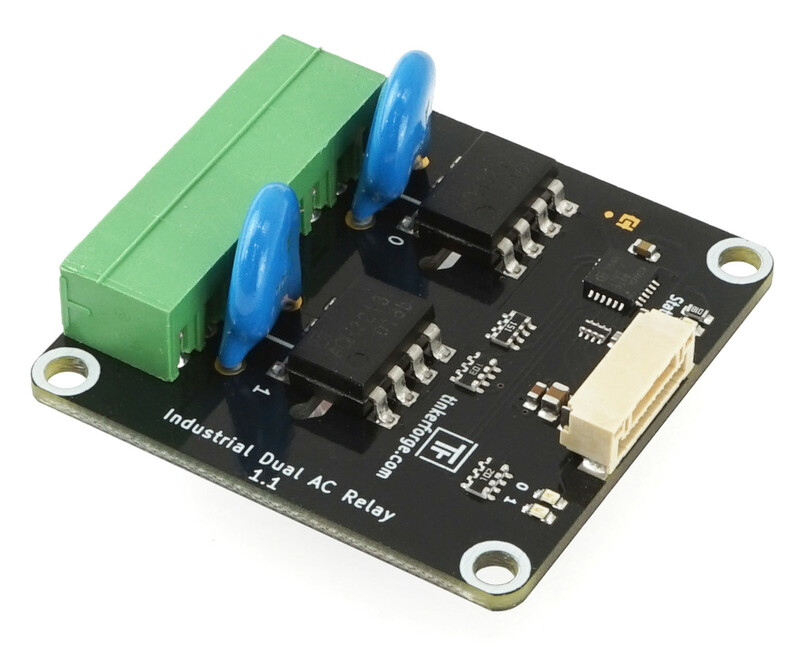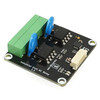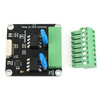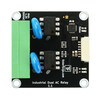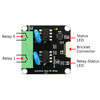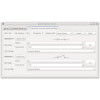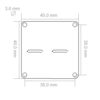- Getting Started
- Hardware
- Bricks
- Bricklets
- Accelerometer Bricklet 2.0
- Air Quality Bricklet
- Ambient Light Bricklet 3.0
- Analog In Bricklet 3.0
- Analog Out Bricklet 2.0
- Analog Out Bricklet 3.0
- Barometer Bricklet
- Barometer Bricklet 2.0
- Breakout Bricklet
- CAN Bricklet
- CAN Bricklet 2.0
- CO2 Bricklet 2.0
- Color Bricklet
- Color Bricklet 2.0
- Compass Bricklet
- DC Bricklet 2.0
- Distance IR Bricklet
- Distance IR Bricklet 2.0
- Distance US Bricklet 2.0
- DMX Bricklet
- Dual Button Bricklet 2.0
- Dust Detector Bricklet
- E-Paper 296x128 Bricklet
- Energy Monitor Bricklet
- GPS Bricklet 2.0
- GPS Bricklet 3.0
- Hall Effect Bricklet
- Hall Effect Bricklet 2.0
- Humidity Bricklet 2.0
- IMU Bricklet 3.0
- Industrial Analog Out Bricklet 2.0
- Industrial Counter Bricklet
- Industrial Digital In 4 Bricklet 2.0
- Industrial Digital Out 4 Bricklet
- Industrial Digital Out 4 Bricklet 2.0
- Industrial Dual 0-20mA Bricklet
- Industrial Dual 0-20mA Bricklet 2.0
- Industrial Dual AC Relay Bricklet
- Industrial Dual Analog In Bricklet 2.0
- Industrial Dual Relay Bricklet
- Industrial PTC Bricklet
- Industrial Quad Relay Bricklet 2.0
- IO-16 Bricklet
- IO-16 Bricklet 2.0
- IO-4 Bricklet 2.0
- Isolator Bricklet
- Joystick Bricklet
- Joystick Bricklet 2.0
- Laser Range Finder Bricklet 2.0
- LCD 128x64 Bricklet
- LCD 20x4 Bricklet
- LED Strip Bricklet 2.0
- Line Bricklet
- Linear Poti Bricklet
- Linear Poti Bricklet 2.0
- Load Cell Bricklet 2.0
- Motion Detector Bricklet 2.0
- Motorized Linear Poti Bricklet
- Multi Touch Bricklet
- Multi Touch Bricklet 2.0
- NFC Bricklet
- OLED 128x64 Bricklet 2.0
- OLED 64x48 Bricklet
- One Wire Bricklet
- Outdoor Weather Bricklet
- Particulate Matter Bricklet
- Performance DC Bricklet
- Piezo Speaker Bricklet
- Piezo Speaker Bricklet 2.0
- Real-Time Clock Bricklet
- Real-Time Clock Bricklet 2.0
- Remote Switch Bricklet 2.0
- RGB LED Bricklet 2.0
- RGB LED Button Bricklet
- Rotary Encoder Bricklet 2.0
- Rotary Poti Bricklet
- Rotary Poti Bricklet 2.0
- RS232 Bricklet
- RS232 Bricklet 2.0
- RS485 Bricklet
- Segment Display 4x7 Bricklet
- Segment Display 4x7 Bricklet 2.0
- Servo Bricklet 2.0
- Silent Stepper Bricklet 2.0
- Solid State Relay Bricklet 2.0
- Sound Intensity Bricklet
- Sound Pressure Level Bricklet
- Temperature Bricklet
- Temperature Bricklet 2.0
- Temperature IR Bricklet 2.0
- Thermal Imaging Bricklet
- Thermocouple Bricklet 2.0
- Tilt Bricklet
- UV Light Bricklet 2.0
- Voltage/Current Bricklet 2.0
- XMC1400 Breakout Bricklet
- Master Extensions
- Power Supplies
- Discontinued Products
- Timeline
- Software
- Kits
- Embedded Boards
- Specifications
Industrial Dual AC Relay Bricklet¶
Features¶
- Two solid state relays for switching AC devices
- Switches up to 240VAC/1.2A (with max 12A surge current)
- Switching done during zero-crossing
Description¶
The Industrial Dual AC Relay Bricklet can be used to extend the features of Bricks by two solid state relays (SSR). Each relay has two terminals. The state is visualized by a LED.
You can use this Bricklet to switch power supplies, motors, lamps, etc. Consider the maximum voltage and current.
Warning
Terminals and contacts are not insulated. If you want to switch higher voltages, consider to put the Dual AC Relay Bricklet in a casing. Touching the contacts is potentially life-threatening!
Technical Specifications¶
| Property | Value |
|---|---|
| Solid State Relay | Panasonic AQH3213A |
| Current Consumption | 25mW (5mA at 5V)
+ 60mW (12mA at 5V) per activated relay
|
| Maximum Voltage/Current | AC 240V/1.2A (with max 12A surge current) |
| Dimensions (W x D x H) | 40 x 40 x 16mm (1.57 x 1.57 x 0.63") |
| Weight | 11g |
Resources¶
Connectivity¶
The following picture shows the different connection possibilities of the Industrial Dual AC Relay Bricklet.

Test your Industrial Dual AC Relay Bricklet¶
To test a Industrial Dual AC Relay Bricklet you need to have Brick Daemon and Brick Viewer installed. Brick Daemon acts as a proxy between the USB interface of the Bricks and the API bindings. Brick Viewer connects to Brick Daemon. It helps to figure out basic information about the connected Bricks and Bricklets and allows to test them.
Connect the Industrial Dual AC Relay Bricklet to a Brick with a Bricklet Cable.
If you connect the Brick to the PC over USB, you should see a new tab named "Industrial Dual AC Relay Bricklet" in the Brick Viewer after a moment. Select this tab. If everything went as expected the Brick Viewer should look as depicted below.
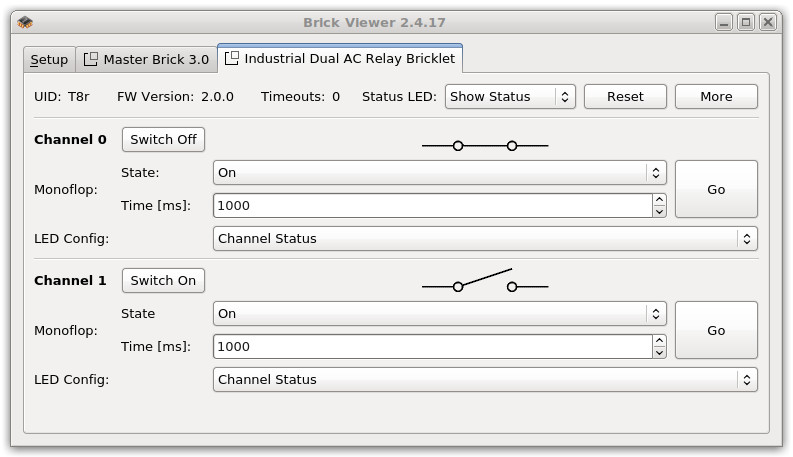
After this test you can go on with writing your own application. See the Programming Interface section for the API of the Industrial Dual AC Relay Bricklet and examples in different programming languages.
Play around with the two relay buttons, an LED indicates the current state of each relay.
Case¶
A laser-cut case for the Industrial Dual Relay Bricklet and Industrial Dual AC Relay Bricklet is available (images show Industrial Dual Relay Bricklet).
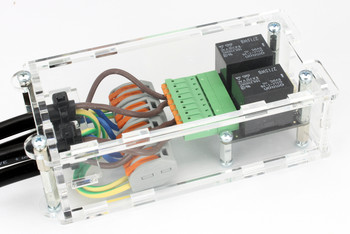
The case of the Industrial Dual AC Relay Bricklet is delivered including cable ties for a cable relief and WAGO connecting clamps to join wires. The case is big enough to accommodate the cable relief as well as the WAGO clamps.
The internal construction can look as follows (with one as well as two relays connected)
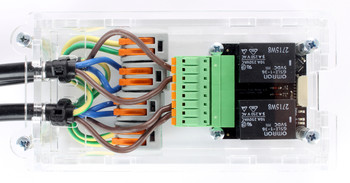
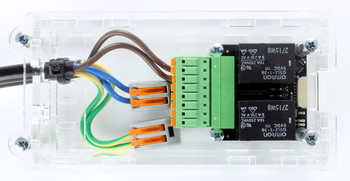
The protective conductor (brown) is switched with the Industrial Dual AC Relay Bricklet. The external conductor (green-yellow) and the neutral conductor (blue) are coupled with the WAGO connecting clamps.
It is important that the external conductor is longer then the other cables. This way it is assured that the external conductor will be pulled of at last if the cable relief is overstrained or defect. We recommend the following length for the cables and the stripping:
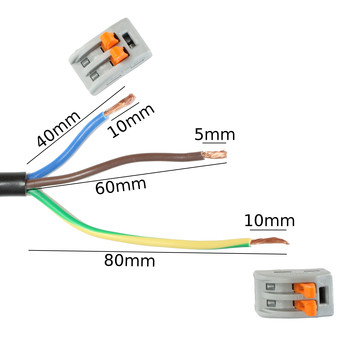
The assembly is easiest if you follow the following steps:
- screw spacers to Bricklet
- screw Bricklet to bottom plate with spacers
- build up side plates (including cable relief)
- plug side plates into bottom plate
- add cabling and WAGO clamps
- tie cable ties to cables
- screw top plate to top spacers
Warning
Never work inside the case when components are carrying voltage!
The exact position of each part can be seen in the following exploded assembly drawing of the Industrial Dual AC Relay Bricklet case:
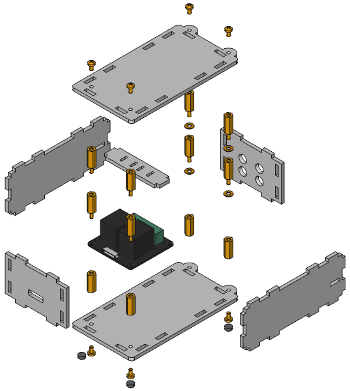
Hint: There is a protective film on both sides of the plates, you have to remove it before assembly.
Programming Interface¶
See Programming Interface for a detailed description.
| Language | API | Examples | Installation |
|---|---|---|---|
| C/C++ | API | Examples | Installation |
| C/C++ for Microcontrollers | API | Examples | Installation |
| C# | API | Examples | Installation |
| Delphi/Lazarus | API | Examples | Installation |
| Go | API | Examples | Installation |
| Java | API | Examples | Installation |
| JavaScript | API | Examples | Installation |
| LabVIEW | API | Examples | Installation |
| Mathematica | API | Examples | Installation |
| MATLAB/Octave | API | Examples | Installation |
| MQTT | API | Examples | Installation |
| openHAB | API | Examples | Installation |
| Perl | API | Examples | Installation |
| PHP | API | Examples | Installation |
| Python | API | Examples | Installation |
| Ruby | API | Examples | Installation |
| Rust | API | Examples | Installation |
| Shell | API | Examples | Installation |
| Visual Basic .NET | API | Examples | Installation |
| TCP/IP | API | ||
| Modbus | API |


